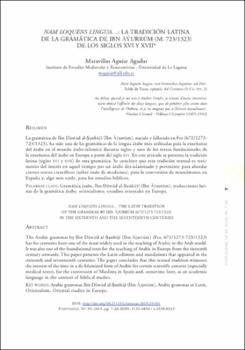Nam loquens lingua…: La tradición latina de la gramática de Ibn Āŷurrūm (m. 723/1323) de los siglos XVI y XVII
Author
Aguiar Aguilar, Maravillas
Date
2019Abstract
La gramática de Ibn Dāwūd al-Ṣanhāŷī (Ibn āŷurrūm), nacido y fallecido en Fez (672/1273-
723/1323), ha sido una de las gramáticas de la lengua árabe más utilizadas para la enseñanza
del árabe en el mundo árabe-islámico durante siglos y uno de los textos fundacionales de
la enseñanza del árabe en Europa a partir del siglo XVI. En este artículo se presenta la tradición
latina (siglos XVI y XVII) de esta gramática. Se concluye que esta tradición textual es testimonio
del interés en aquel tiempo por un árabe des-islamizado y pertinente para abordar
ciertos textos científicos (sobre todo de medicina), para la conversión de musulmanes en
España y, algo más tarde, para los estudios bíblicos. The Arabic grammar by Ibn Dāwūd al-Ṣanhājī (Ibn ājurrūm) (Fez, 672/1273-723/1323)
has for centuries been one of the most widely used in the teaching of Arabic in the Arab world.
Itwas also one of the foundational texts for the teaching of Arabic in Europe from the sixteenth
century onwards. This paper presents the Latin editions and translations that appeared in the
sixteenth and seventeenth centuries. The paper concludes that this textual tradition witnesses
the interest of the time in a de-Islamized form ofArabic for certain scientific content (especially
medical texts), for the conversion of Muslims in Spain and, sometime later, as an academic
language in the context of biblical studies.





